Gameweek 29 of Allsvenskan 2020 ended with a clash between Hammarby IF and IFK Norrkoping at the Tele2Arena. It is still a very meaningful match as both teams are still possible to contest for the third place of the league, which could represent Sweden to play in Europe in the coming season.
After Christoffer Nyman scoring the only goal, helping Jens Gustafsson’s team to win the game, the guest could keep their hope until the last week of the league. On the contrary, Hammarby are out of the contest as the margin is too big already.
However, the result does not suggest Stefan Billborn’s men are completely outplayed by the opponent. Instead, it was a close game, and the home side could have won it if they were more clinical. This tactical analysis reveals the tactics of both sides in the open plays.
Lineups
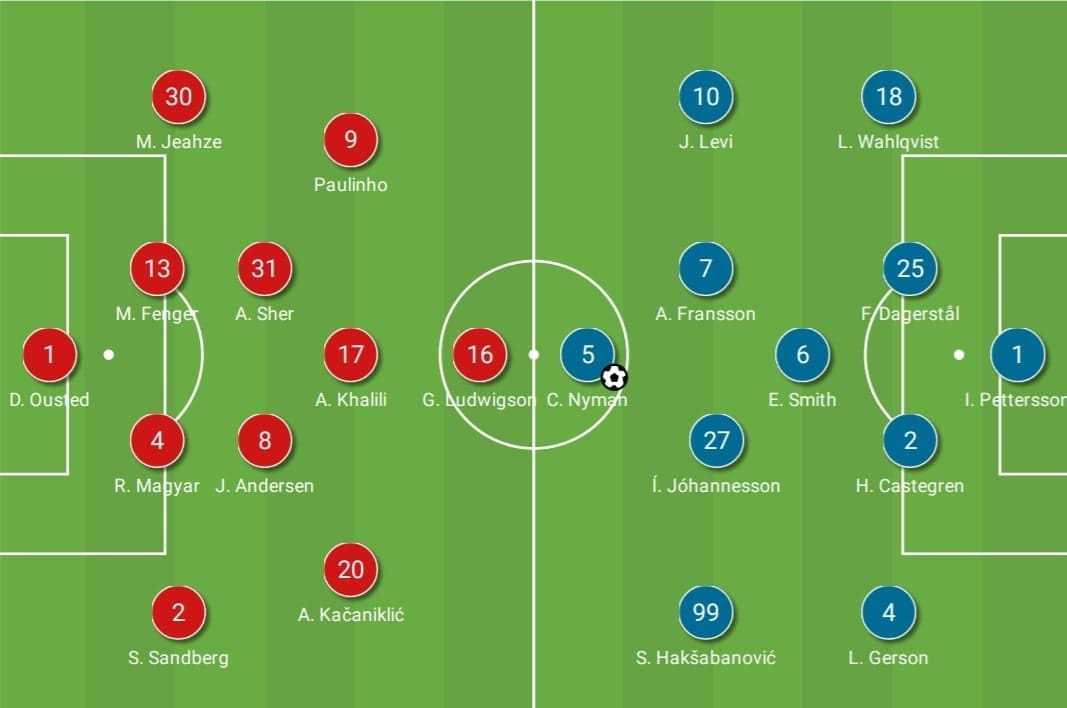
The team started by Billborn was quite different from the one that drew against Malmö FF last week. David Fällman and Tim Söderström were replaced by Mohanad Jeahze and Richárd Magyar. No Aron Jóhannsson in the squad while Paulinho was playing as the left-winger.
Gustfasson sent his best troops to fight for the victory, the only change was the return of Alexander Fransson, who replaced Simon Thern at the midfield. Of course, the dangerous man – Nyman led the line and made the difference again.
Hammarby playing down flanks
Norrköping stuck to their relatively conservative defensive style away from home. The team set a midblock, pressing just in front of the defensive third instead of high up on the pitch. Thus, the approach would invite the opposition pushing players forward, organizing the attack at the central third. When they were trying to pressure the ball, midfielders from the same vertical zone could step up, resulting in a 4-4-1-1 or 4-4-2. However, the intention was not to win the ball high, so they seldom attacked the ball.
Hammarby tried several methods to construct their attack in this game. In the early stages, the defensive midfielders involved a lot in the build-up – usually, Jeppe Andersen dropping at the right half-spaces, outside of the block while Aimar Sher providing an additional layer. Abdul Kahlili, the offensive midfielder also came outside of the block to receive the ball, forming a 3-2 or a 3-1 shape. With a back three at the back and tighter distances between players, ball circulation was fluid and options around the ball were easily generated.
For example, the below image shows the 3-1 shape of the home side. Even Andersen could not play the ball forward because of confronting pressure, he could simply play the ball to either centre-backs and reorganize the attack.
Usually, the players at the outside of the block had time and spaces, as well as an optimal body orientation to play the forward passes.
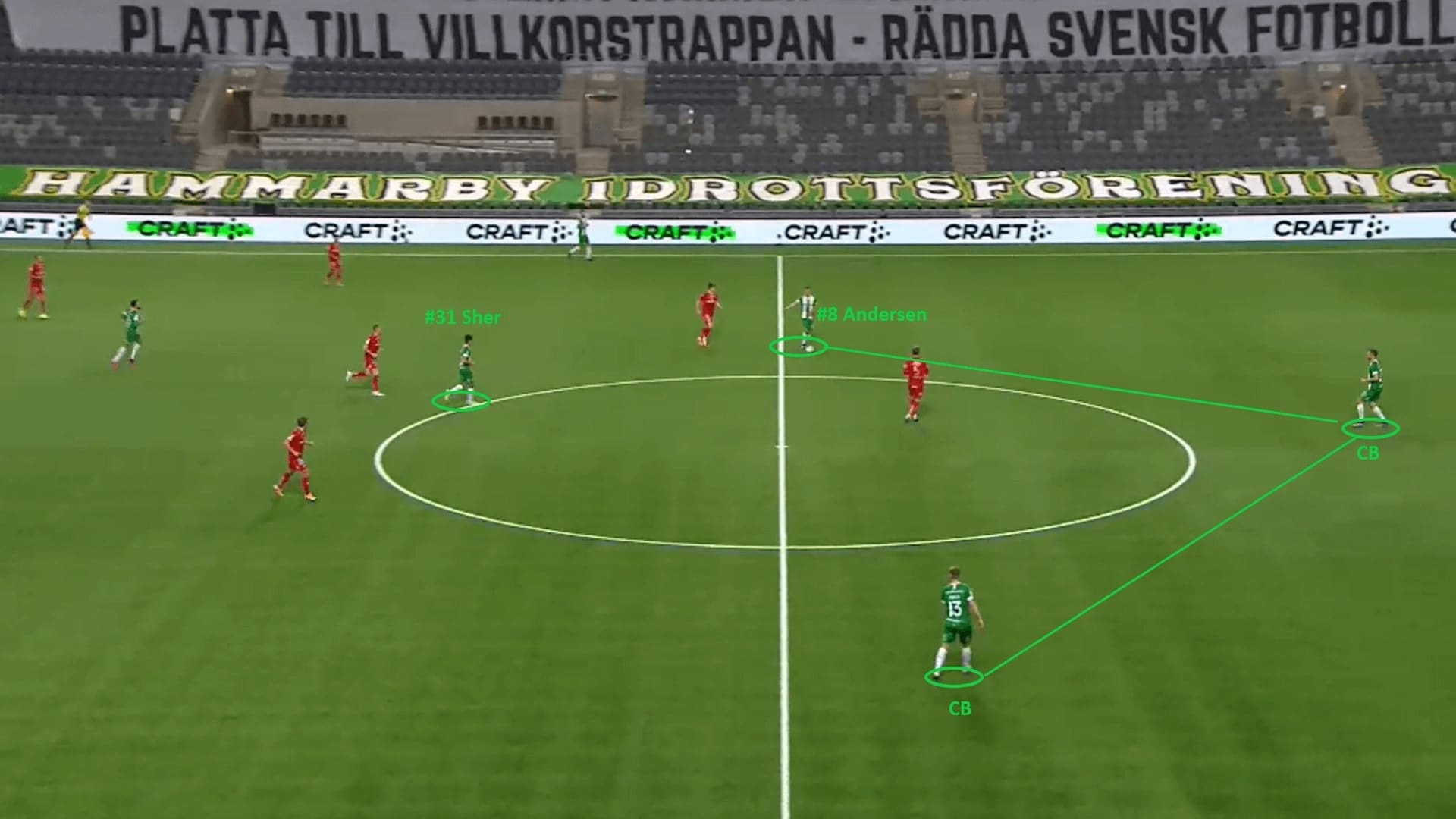
Since Norrköping only applied light pressure, the home side did not need too many players to drop outside of the block. As the game continued, Billborn’s side looked to pin the opposition deeper and narrower by positionings. An important progressing routine has appeared again, which Is the LCB-LB sequence below.
Instead of giving all the balls to Andersen to initiate the attack, Hammarby centre-backs were encouraged to bring the ball forward at the half-spaces. Firstly, they should have bypassed the first line – only Nyman there. Secondly, if they could draw the attention or even require the opposition wingers to fix positions, spaces were opened for the full-backs.
Bajen often developed the attack from the left, including the example below. An important detail was to pass the ball to the front foot of the left-back, allowing his first touch to bypass the second line of defence if possible. If they did these things correctly, they could advance into the final third very quickly.
The below image is a collaborated scenario by the host. With the wingers staying narrowly to keep the back four at the centre, the wide zone was opened for the left-back. Meanwhile, Fenger did great to force the right-winger adjusting position, then releasing Jeahze.
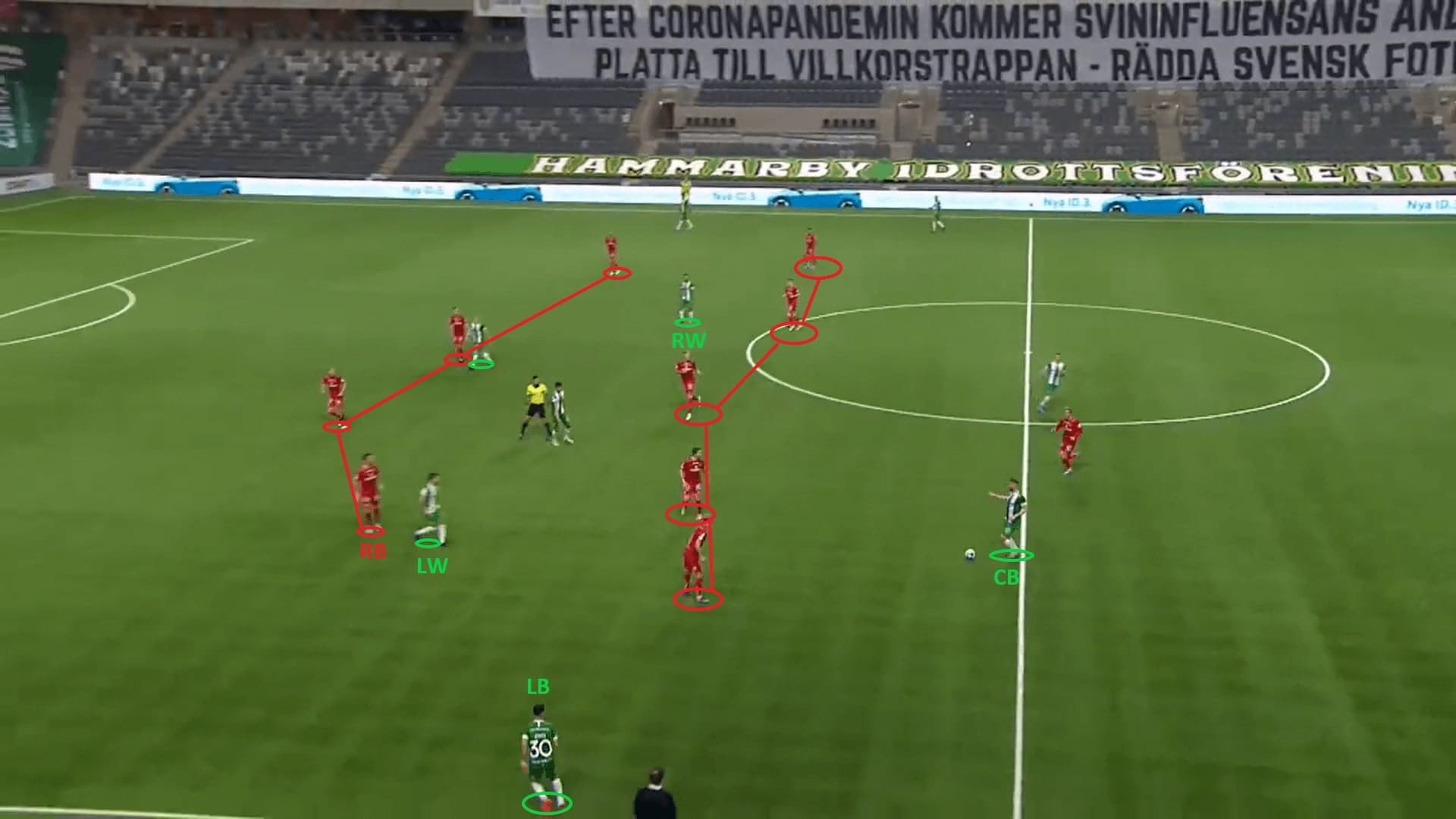
When Jeahze was released, he would then find his teammates supporting at the centre. The attacking players would all staying between the lines, searching for the attacking depth in the process. As the flat second line of Norrköping was bypassed, the full-back could play the ball centrally.
This is a part that Hammarby should improve in their offensive plays. Even though spaces and passing lanes were available, the receivers were not always ready for the pass. Sometimes they could not reach the ball because of suboptimal timing or direction of movements. Under those circumstances, there were many possible combinations, such as the lateral third-man plays which could further put the ball into the penalty box.
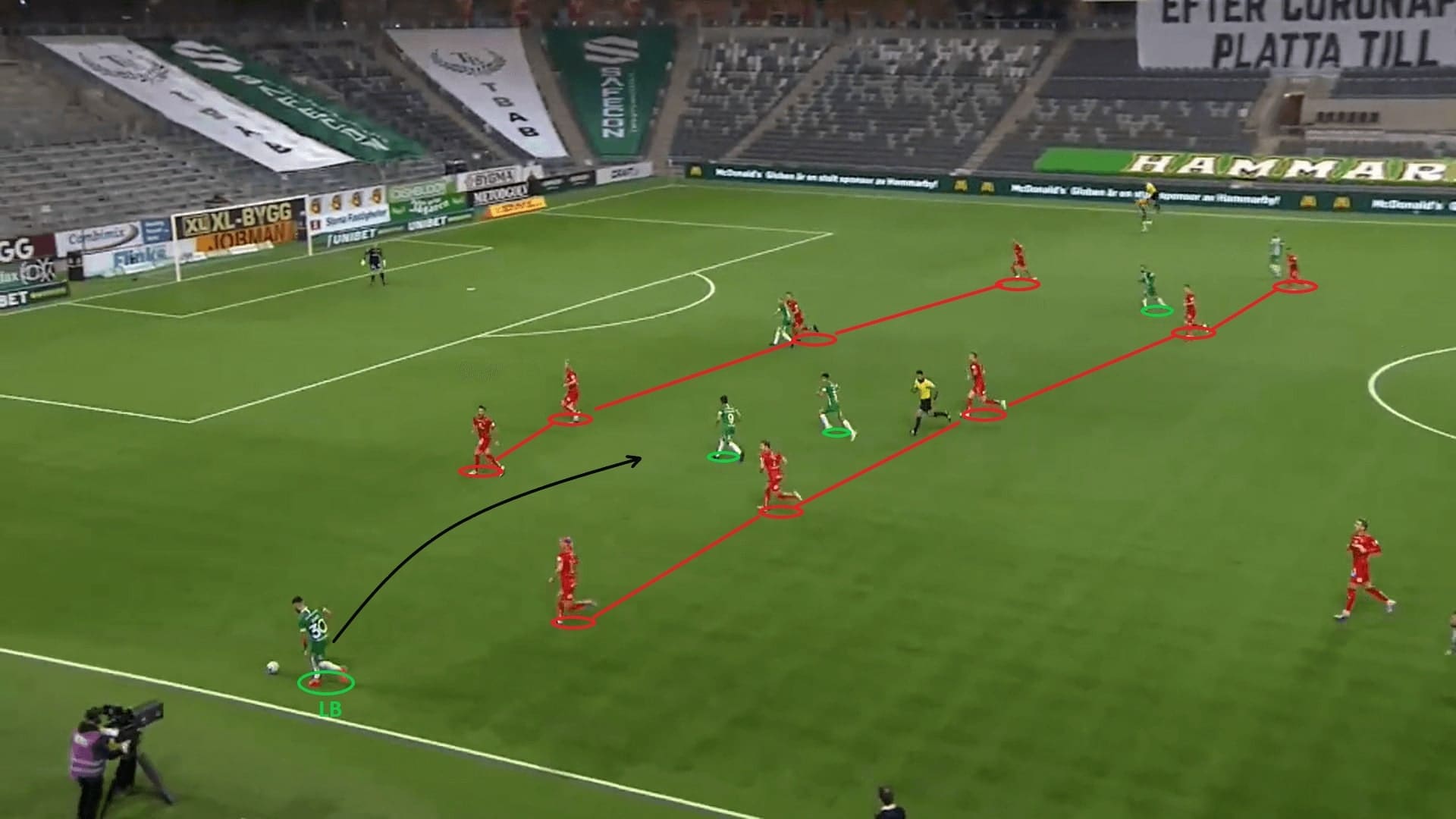
Or, alternatively, if a Hammarby player reached zone 16 or zone 18, the teammates would support by committing three to five players inside the penalty box. Hammarby also had dynamic strategies to attack the penalty box – including different timings and multiple attacking angles.
Here, the example shows the delivery was made in zone 16. Bajen had four players to attack the box. The striker – Gustav Ludwigson should always attack the six-yard box, his forward movements would force the backline dropping deeper. As a chain effect, spaces were opened near the penalty spot, especially when the second line was yet to drop deep (the ball must go faster than players). Also, the three attacking players behind the striker could attack from three vertical zones – as shown by Paulinho, A. Khalili, and Alexander Kačaniklić below.
This dynamic strategy has created some golden opportunities for the team, including an 0.33 xG chance that the former Liverpool academy player – Kačaniklić could not convert.
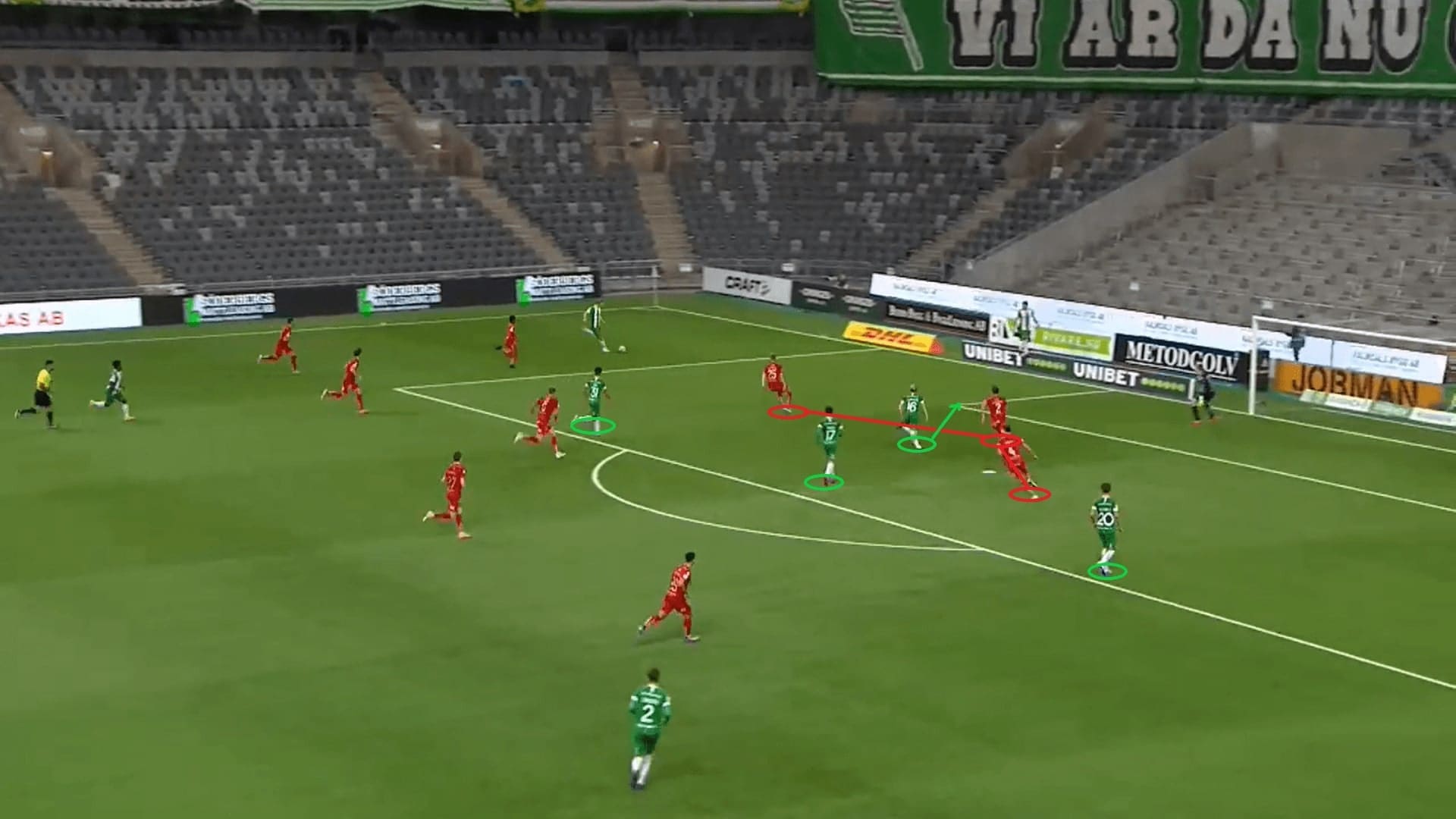
Not the best second half from Bajen
Despite created opportunities that valued 1.99 xG in the first half, the team could not keep it up and produce more in the second half. Instead, the figure reduced drastically to 0.57 in the last 45, which was quite disappointing. There were a few reasons that led to the drop in attacking form. From Peking’s perspective, Gustafsson cleverly adjusted the defence a bit – instructing the winger to defend deeper, controlling the Hammarby left-back. This has weakened the LCB-LB linkage as mentioned in the above analysis.
From Hammarby’s perspective, they were too eager to level things up, but the quality of the first ball was not fine enough. In the offensive phases, the team shape opened too early when the full-backs pushed high and wide. On some occasions, such as the below image, they were in a 3-1-6 shape already in the first phase. Six attacking channels were opened but resulted in weak interconnectedness between players. The flat shape has limited the angles for players to play quick combinations, while the team lacking the offensive layers to bypass the opposition lines one by one.
Therefore, Bajen were more direct in the second half. They tried to release the runner(s) who was searching for the offensive depth, playing the ball into spaces. However, when the ball was off the ground, the continuity of the attack was also lowered as it was difficult to control.
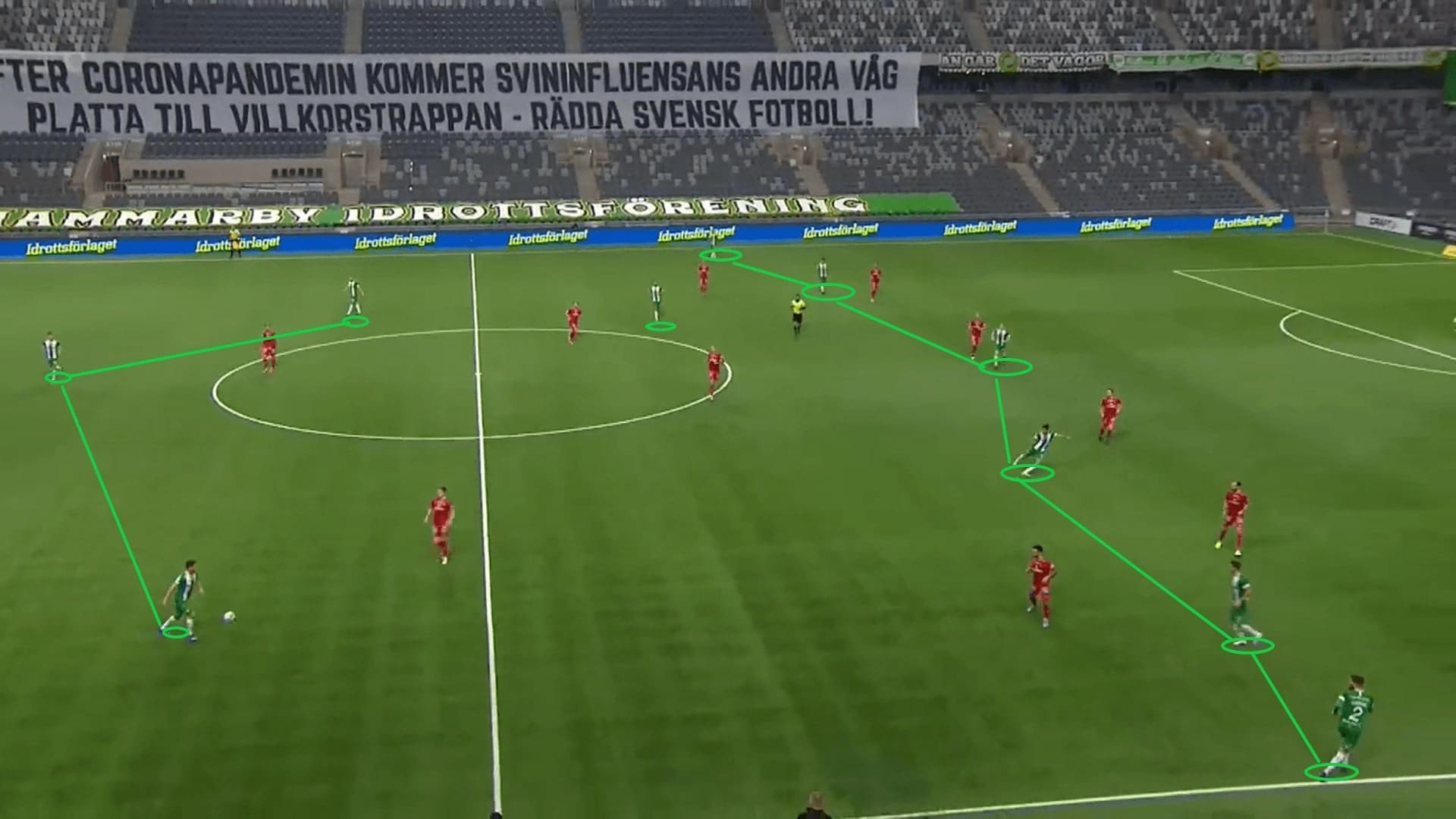
As mentioned above, Norrköping defended deeper with the winger almost playing like a wing-back. It was shown below as Jonathan Levi was staying in the same horizontal zone with the backline, defending the left-back. The shape was more like a 5-4-1, they were still committing more numbers on the ball side. Also, the engagement height of the team was also deeper to minimize vertical spaces between the lines. These were on-spot solutions to the defensive issues in the first half.
The way for Hammarby to hit the weak spot of the defence was to switch the ball from flank to flank. Usually, this began with a lofted ball at the backline because of the big shape, such as the below example. It was impossible for Nyman to chase this, while the opposition midfielder was dragged out because of the defensive scheme as explained.
With a man less in the second line, horizontal coverage was weakened. The defence on the weak side was loose as shown in the image.
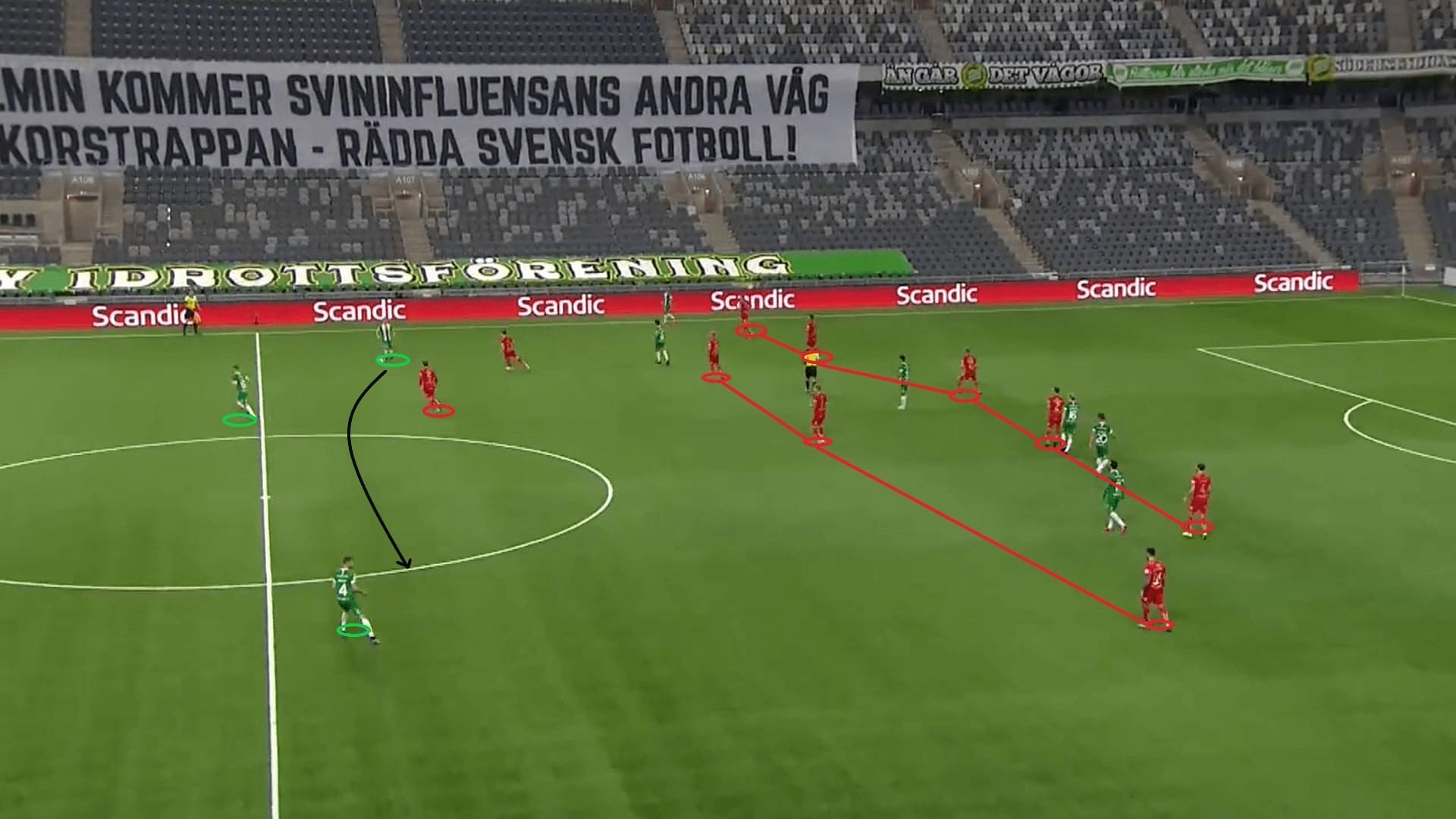
Therefore, when Magyar received the ball on the weak side, he has time and spaces to play the ball forward. To reduce the passing distance, players at the front line, mostly A. Khalili should drop into the “holes” created during the shifting, or else Peking could easily defend by staying close to receivers at the backline.
Here, A. Khalili dropped to look for the ball, allowing Magyur to find him. He was at the inside of the block, without the marker following as Simon Sandburg manipulated the left-back for him. There were spaces to turn and further develop the attack when Bajen seized the momentum to attack.
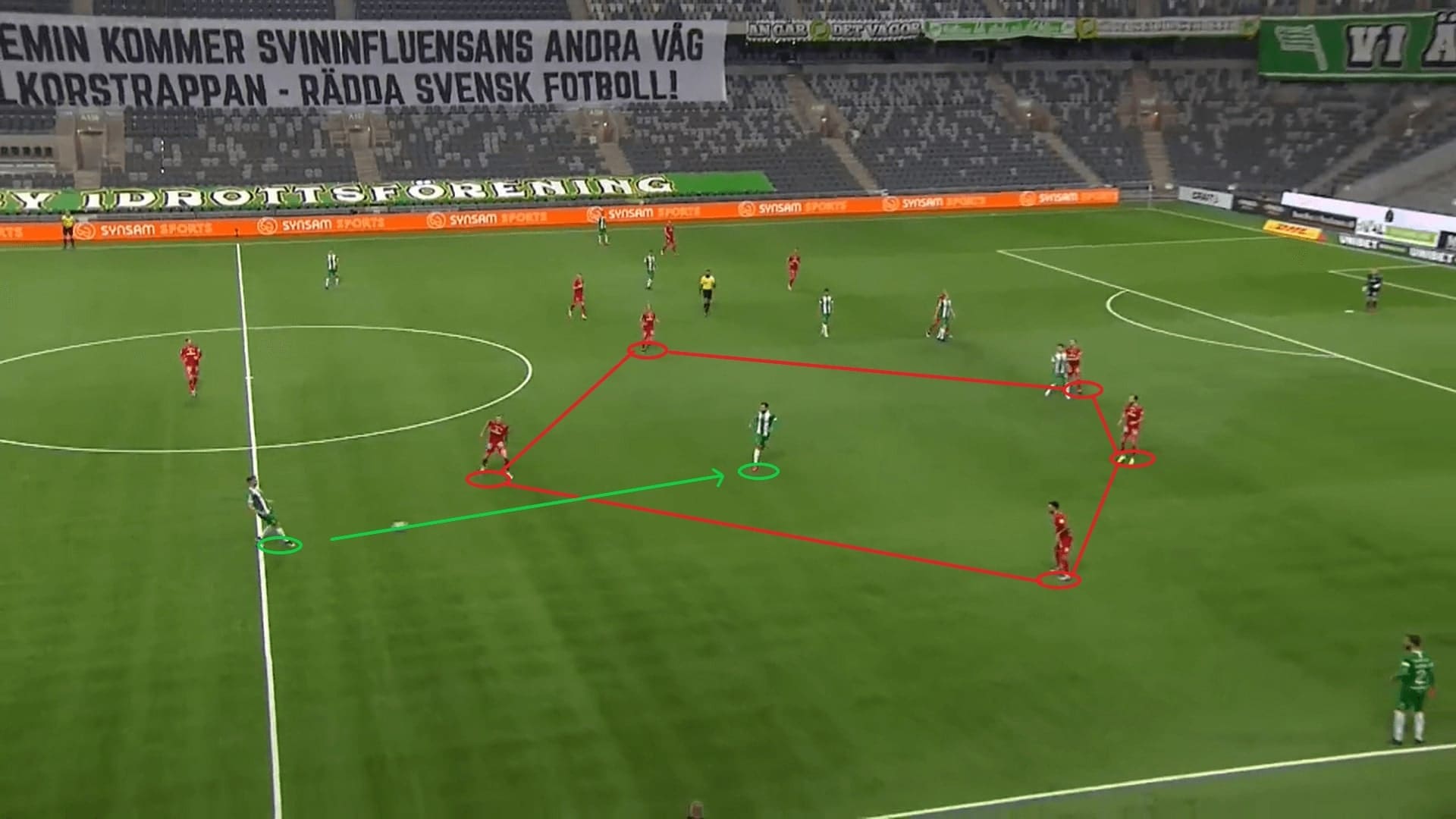
Norrköping’s effective approach to evade the block
Despite not creating as many chances as the opponent did, the way that Norrköping used to bypass the press was still worth to analyze. Against Hammarby who set the press high, Gustafsson and his coaching were well-prepared to exploit the flaws of the opponents.
Firstly, it is important to understand the defensive scheme of the host. In the first phase, against the 2-1 triangular build-up shape, Hammarby would commit Ludwigson and A. Khalili to press alternatively. The priority was to cover the pivot while pressing one of the centre-backs, while it would be the best if the passing lane between the centre-backs was cut. The 2 v 3 numerical deficit in this part was calculated.
When the advanced midfielders of Norrköping dropped, the respective midfielder should follow and keep him under an accessible distance. This usually resulted in the occurrence of high-low midfielder – Sher and Andersen staying in different horizontal zones. In the scenario below, Sher stepped up to follow Fransson while Andersen was deeper to cover Ísak Bergmann Jóhannesson.
Meanwhile, the ball-side winger should stay close and man-mark the corresponding full-back. As an example, the former Watford and Fulham man – Kačaniklić stay closer to Lars Gerson at the expense of leaving half-spaces opened. The right-back and left-back should try to mark the dropping wingers as well, especially the one on the ball-side.
Since Bajen were outnumbered in the first phase, they could not initiate the press actively – Peking centre-backs spread wide enough to increase the accessing distances. They could only wait for signals such as lateral passes between the centre-backs, then slowly shifting the duties.
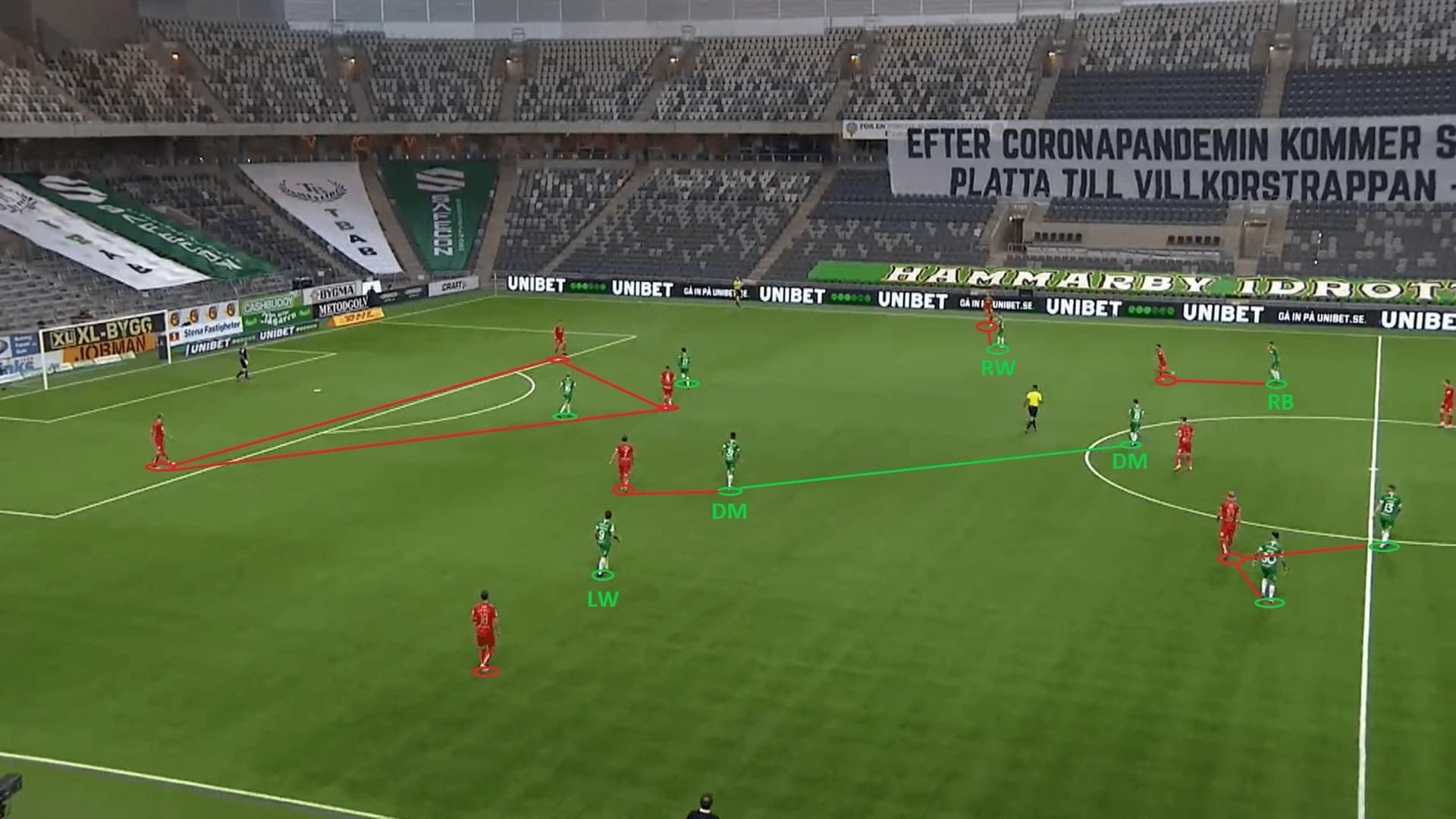
Norrköping were smart enough to deployed various tactics to bypass the press. The first example – using the right-winger was shown in the below example. As expected, the high-low midfielders of Hammarby would leave their midfield spaces opened, so when the wingers operating narrowly could exploit those areas.
Whenever Sher or Andersen stepped up, spaces were available at their back – mostly the former was dragged out as Fransson tended to drop. The below example shows how Levi entered spaces behind Sher to open a vertical passing lane, allowing the pivot to break the press – Norrköping bypassed six players.
The front players took too much time to press the ball, while spaces were too huge for Andersen to cover around. Bajen full-backs should have been more aggressive to defend in those situations, if not suffocating the attack, at least delay it.
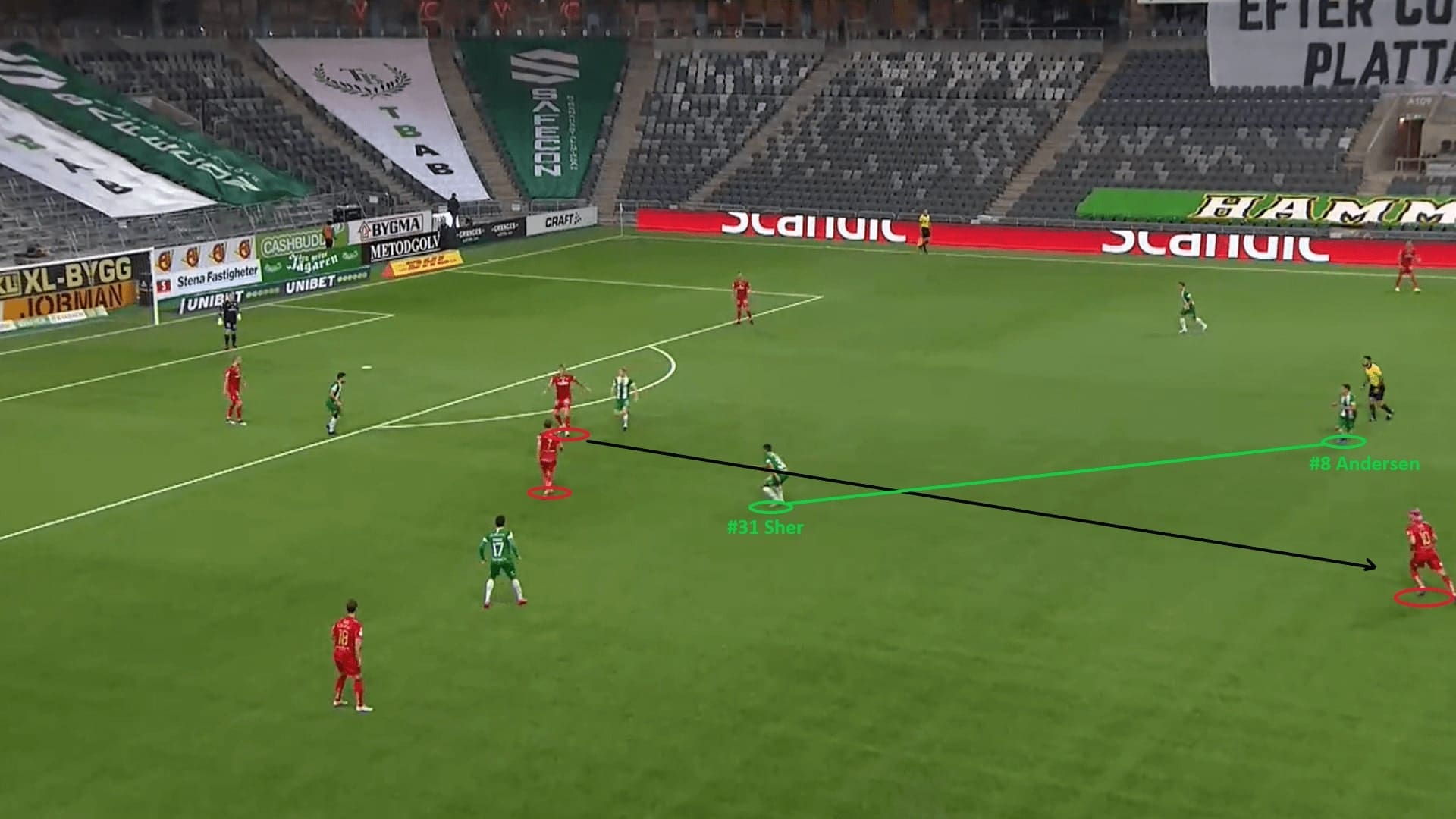
When spaces were available, Norrköping would not hesitate to play more directly to progress the ball into advanced areas quickly. The below example shows Ludwigson pressuring the ball again, but he never seemed to access the target before the pass. It was really difficult to defend in a 2 v 3.
Levi, once again, dropped, pulling the Bajen left-back out of position. Although Paulinho tried to mark the right-back, he was not alert enough to read the pass – leaving Linus Wahlqvist to attack large spaces behind the left-back. This was also the function of the Peking full-backs – going up and down in the wide zones, allowing Levi and Sead Hakšabanović to play narrowly and closer to the goal.
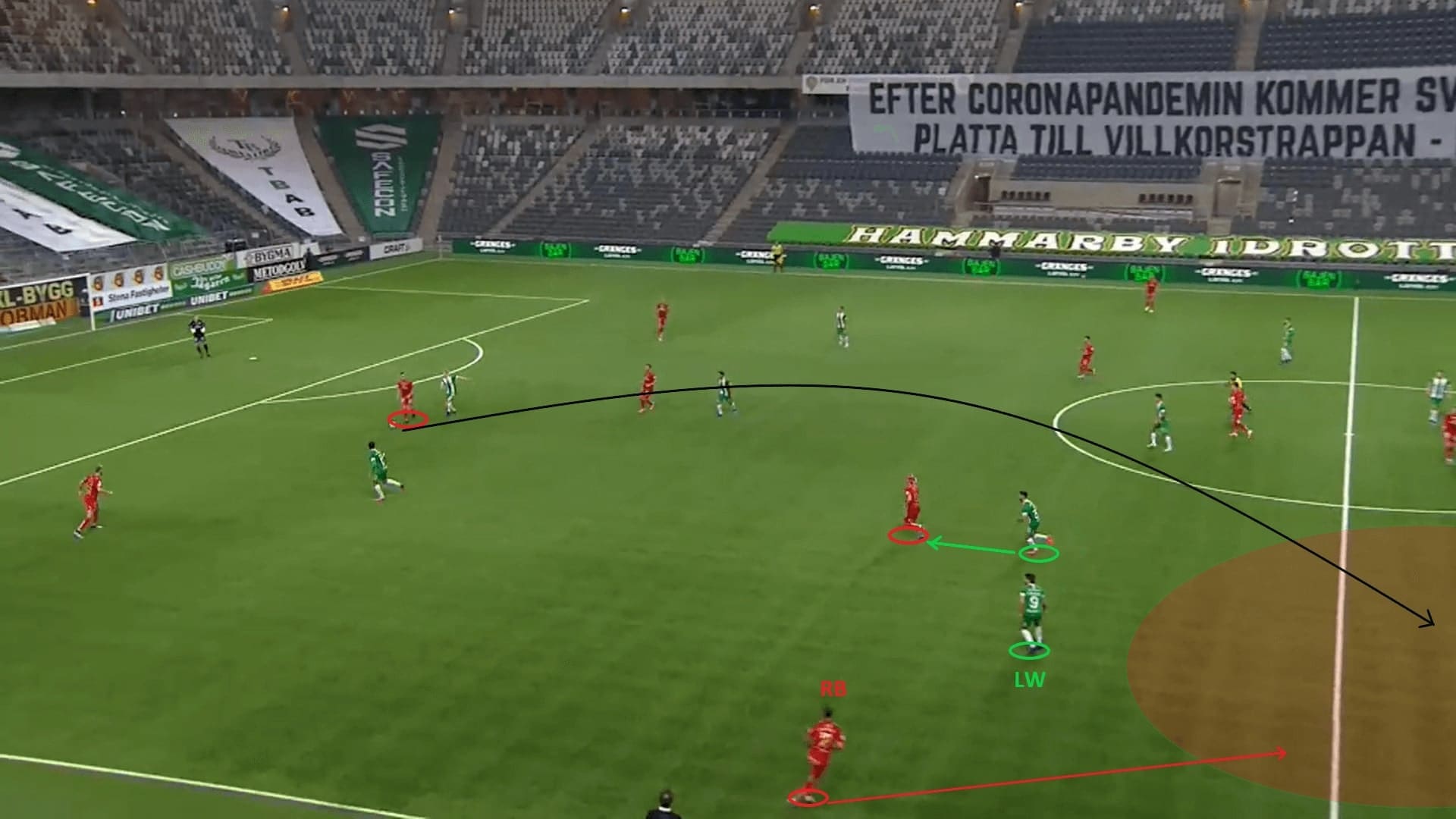
Since Bajen did not apply enough pressure to force the opponent acting in the press, the quality of passes was usually high from Norrköping. Apart from the examples that demonstrated above. Capitalizing on the nature of high-low midfielders, Peking also tried to put the ball behind the second line, then quickly advancing into the final third.
The below example shows the situation after the ball reached behind of Andersen and Sher, in fact, Norrköping had more players than Bajen. It was a 6 v 5 in Hammarby’s half, the defending side only had one player protecting the back four. The carrier could then bring the ball forward or finding the next option(s) to pass – Hammarby were unable to stop those progressions. Nyman’s only goal of the game could also be attributed to this type of offensive play.
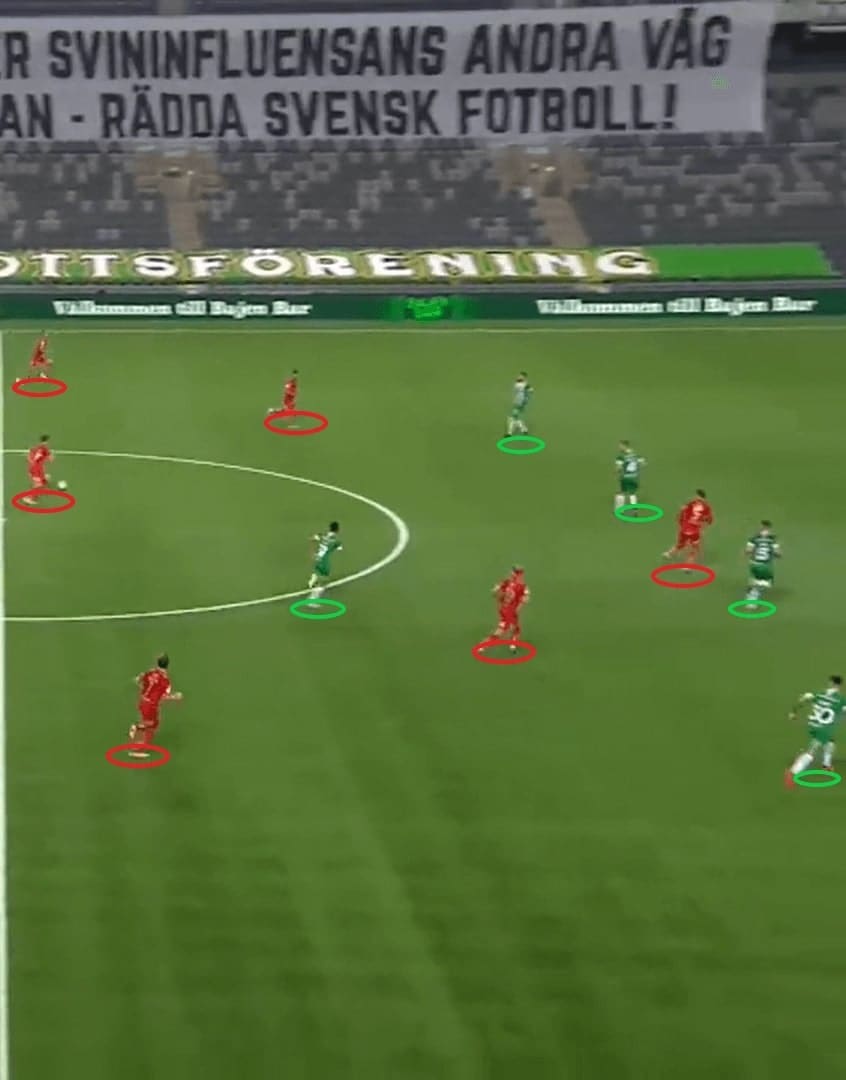
Final remarks
Norrköping are much more direct in the second half, hence, resulting in possession turnover more often. Bajen had more opportunities to organize an attack, but as explained in this analysis, a better structure is needed to enter the final third with higher quality. It was not a bad game from Hammarby, but Peking were clinical in front of the goal to seal the game. Now, we shall wait until the last matchday to see whether Gustafsson can lead his team into the Europa League qualifying in 2021/22.





Comments